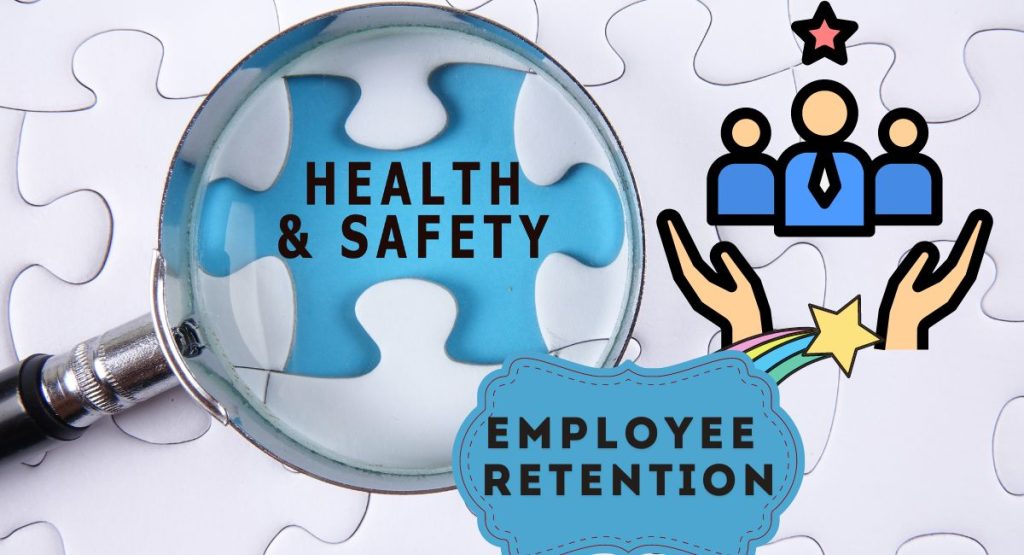In today’s competitive job market, employee retention is a critical concern for businesses. A well-implemented safety and health program can significantly impact employee retention. Such programs not only ensure the well-being of employees but also foster a positive work environment. This article explores how effective safety and health programs contribute to retaining employees and why they are essential for business success.
Understanding Safety and Health Programs:
A safety and health program is a set of policies and procedures aimed at preventing workplace injuries and illnesses. These programs include training, hazard identification, risk assessments, and the implementation of safety measures. The goal is to create a safe and healthy workplace for all employees.
The Link Between Safety, Health, and Employee Retention:

1. Enhanced Employee Morale
A workplace that prioritizes safety and health shows employees that their well-being is valued. This leads to higher job satisfaction and morale. When employees feel safe and cared for, they are more likely to remain loyal to the company. High morale reduces turnover rates and improves productivity.
2. Reduced Absenteeism
Effective safety and health programs reduce workplace accidents and illnesses. This leads to fewer sick days and absenteeism. Employees who are healthy and feel safe at work are more likely to attend regularly and perform better. Reduced absenteeism directly impacts employee retention positively.
3. Increased Job Satisfaction
Job satisfaction is crucial for employee retention. Employees who believe their employer is committed to their safety and health are more satisfied with their jobs. Satisfied employees are less likely to seek employment elsewhere. They are also more engaged and motivated to contribute to the company’s success.
4. Positive Workplace Culture
Safety and health programs promote a culture of care and respect. This positive culture is attractive to employees. When the workplace environment is supportive and healthy, employees are more likely to stay. A strong workplace culture also attracts new talent, further enhancing retention.
5. Trust and Loyalty
Trust is fundamental in the employer-employee relationship. Implementing robust safety and health programs builds trust. Employees trust that their employer will protect them from harm. This trust fosters loyalty. Loyal employees are less likely to leave, ensuring long-term retention.
Components of an Effective Safety and Health Program:

1. Comprehensive Training
Training is the cornerstone of any safety and health program. Employees must be educated on safety protocols and procedures. Regular training sessions ensure that safety measures are understood and followed. Training should be ongoing to adapt to new risks and safety practices.
2. Hazard Identification and Risk Assessment
Identifying potential hazards and assessing risks is crucial. Regular inspections and risk assessments help identify areas that need improvement. Addressing these hazards promptly prevents accidents and illnesses. A proactive approach to safety demonstrates a commitment to employee well-being.
3. Employee Involvement
Involving employees in safety and health programs is essential. Employees can provide valuable insights into potential hazards and solutions. Creating safety committees or having regular safety meetings encourages employee participation. When employees are involved, they feel more responsible for their safety and the safety of their colleagues.
4. Clear Communication
Communication is key to the success of safety and health programs. Policies and procedures must be clearly communicated to all employees. This includes emergency procedures, reporting mechanisms, and safety guidelines. Clear communication ensures that everyone understands their role in maintaining a safe workplace.
5. Management Commitment
The commitment of management to safety and health programs is critical. Management must lead by example and prioritize safety in all aspects of the business. This includes allocating resources for safety initiatives and addressing safety concerns promptly. Management’s commitment sets the tone for the entire organization.
Benefits of a Well-Implemented Safety and Health Program:

1. Financial Savings
Workplace accidents and illnesses can be costly. They lead to medical expenses, compensation claims, and lost productivity. A well-implemented safety and health program reduces these costs. The financial savings can be significant, allowing companies to invest in other areas.
2. Legal Compliance
Compliance with safety and health regulations is mandatory. Failure to comply can result in legal penalties and fines. An effective program ensures compliance with all relevant laws and regulations. This protects the company from legal issues and enhances its reputation.
3. Enhanced Reputation
Companies known for their commitment to safety and health are more attractive to potential employees. They also gain the trust of customers and partners. A good reputation in safety and health can be a competitive advantage. It shows that the company values its employees and operates ethically.
4. Improved Employee Well-being
The ultimate goal of safety and health programs is to improve employee well-being. Healthy and safe employees are happier and more productive. They experience less stress and are more likely to remain with the company long-term. Improved well-being benefits both employees and the organization.
Conclusion:
A well-implemented safety and health program is crucial for employee retention. It enhances morale, reduces absenteeism, and increases job satisfaction. By promoting a positive workplace culture and building trust, these programs foster loyalty. The components of an effective program include comprehensive training, hazard identification, employee involvement, clear communication, and management commitment. The benefits are extensive, including financial savings, legal compliance, enhanced reputation, and improved employee well-being. Investing in safety and health is not just a legal obligation; it is a strategic move to ensure the long-term success of the business and the satisfaction of its employees.
Frequently Asked Questions (FAQs):
1. How do safety and health programs improve employee retention?
Answer:
Safety and health programs improve employee retention by creating a safe and supportive work environment. When employees feel their well-being is prioritized, job satisfaction and morale increase. This leads to reduced absenteeism and turnover. Employees who trust their employer to protect them are more likely to remain loyal to the company, enhancing overall retention.
2. What are the key components of an effective safety and health program?
Answer:
The key components of an effective safety and health program include:
Comprehensive Training: Regular and ongoing safety training sessions.
Hazard Identification and Risk Assessment: Regular inspections and proactive risk management.
Employee Involvement: Encouraging participation in safety committees and meetings.
Clear Communication: Ensuring all safety policies and procedures are well communicated.
Management Commitment: Strong leadership support and resource allocation for safety initiatives.
3. What are the financial benefits of implementing a safety and health program?
Answer:
Implementing a safety and health program can lead to significant financial benefits by reducing costs associated with workplace accidents and illnesses. These savings come from lower medical expenses, fewer compensation claims, and increased productivity due to reduced absenteeism. Additionally, a safe workplace can lower insurance premiums and avoid legal fines for non-compliance with safety regulations.
4. How does a positive workplace culture impact employee retention?
Answer:
A positive workplace culture, fostered by strong safety and health programs, impacts employee retention by creating an environment where employees feel valued and respected. This culture promotes job satisfaction, loyalty, and a sense of belonging, which are critical factors in retaining employees. A supportive and healthy work environment also attracts new talent, further stabilizing the workforce.
5. Why is management commitment crucial for the success of safety and health programs?
Answer:
Management commitment is crucial because it sets the tone for the entire organization. When management prioritizes safety and health, it signals to employees that their well-being is a top priority. This commitment includes providing necessary resources, addressing safety concerns promptly, and leading by example. Strong management support ensures the successful implementation and sustainability of safety and health programs, thereby enhancing employee retention.
How to Conduct a New York Business Entity Search
Business Codes For Schedule C Filers
Merchant Cash Advance Blursoft for Quick Cash Boosts: Unlocking Business Growth



It is perfect time to make some plans for the future and it is time to be happy.
I’ve learn this post and if I may I want to counsel you few attention-grabbing things
or tips. Perhaps you can write next articles referring to this
article. I desire to read more issues approximately it!
I will immediately snatch your rss feed as I can not
to find your email subscription link or e-newsletter service.
Do you’ve any? Kindly permit me realize so that I may just subscribe.
Thanks.